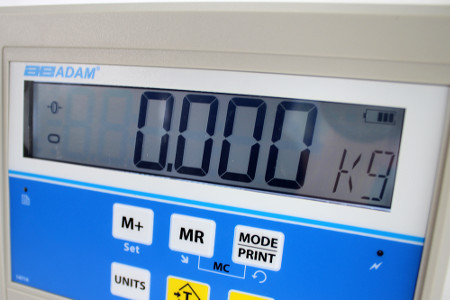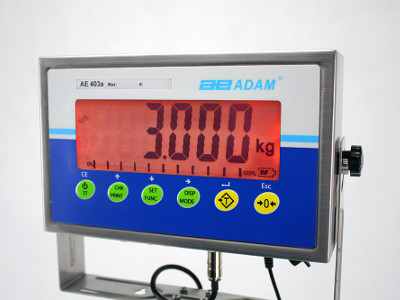
You found the perfect platform, now it’s time to get a weighing indicator. But which option is right for you? This buying guide will help you pick the best indicator for your needs and explain the differences between the different types.
What is a weighing indicator?
Essentially, a weighing indicator is a device that turns electric signals (that are caused by distortions in the base’s load cells) into something that can be read by users. The signals are converted to legible results on the display integrated to the indicator. Indicators include various applications to add functionalities (like counting or checkweighing) to platforms, offer data communication capabilities and buttons to navigate through menus or for sample entry.
Indicators can be placed on stands, wall brackets or just connected by cable to accommodate platform placement.
Why get a platform and an indicator separately?
There are a few reasons to consider a separate purchase. Aside from already owning one or the other, or just replacing an old piece, it allows the user to customize their scale as needed. You can combine a platform with the size and capacities best suited to your needs with the most useful features. The scale can then be put together according to your specifications. Why overpay for a scale with six different functions when all you need is weighing? And of course, some people might want a large, high-capacity platform combined with a versatile indicator capable of multiple tasks not limited to weighing.
It can also be useful to have distance between the platform and the indicator. When weighing animals in natural habitats, for example, it can be preferable for staff to stay far away to let them inspect the scale at their leisure. In industrial settings, some objects can pose a safety risk because of their weight or chemical properties, so it’s safer to read the indicator from a distance. Larger companies might own multiple platforms and indicators of the same type, and it can be easier to transport and store them separately or have backups.

Types of indicators
Like scales and balances, there are many kinds of indicators. This list includes the most commonly used indicators and their main features:
Counting indicators
You might have noticed most indicators include a counting function. So what makes a counting indicator different? It’s the inclusion of a full numeric keypad. A full numeric keypad allows users to enter sample numbers, unit weight and more quickly and easily. It’s especially useful when dealing with unwieldy numbers (for example, a unit weight of 15.78 grams) and for large inventories. Counting indicators like our GC can be very useful in shipping, packaging, and inventory tasks, as they can quickly count even small pieces. They also tend to feature freely selectable sample sizes, as opposed to a preset. That means that you could use the keypad to input any number for the sample as long as it’s within the indicator’s capacity, like 14 or 137. Preset sample sizes are usually derived from multiples of 5. It’s not a difficult constraint to work with, but not having to deal with it can speed up tasks, particularly for large or variable inventories. Lastly, while most indicators include a counting function, dedicated counting indicators also feature parts counting optimization, which automatically refines the weight of pieces as they are added to boost accuracy and precision.
Checkweighing indicators
While many indicators include a variety of applications, including checkweighing, a dedicated checkweighing indicator like our GK includes functions designed to speed up checkweighing tasks. LED indicators or even the whole display will change color to indicate if a sample is over, under or within preset limits. They also often include an audible alarm that sounds when a limit is reached, so users don’t even have to look at the indicator while they work.
Label printing indicators
These indicators include a built-in printer that can create labels that include barcodes, QR codes, pictures and custom logos to the 50mm-wide printed labels. They come in varieties with or without full numeric keypads and include a wide variety of features such as counting, percentage weighing, accumulation and more. They’re very useful for retail stores, packaging and shipping facilities since the label is printed directly by the scale. It removes the need for other peripherals and can help reduce the risk of errors. Adam Equipment offers the AE 503 and AE 504 indicators with built-in label printers. You can use the included software to design your own labels for branding and to make sure all the information needed by you and your clients is included.

Trade approved indicators
These indicators feature trade approval (such as OIML or EC, which is required anytime materials or object are sold by weight. Some indicator ranges include trade approved models, so you can still get a dedicated counting or checkweighing indicator that also features trade approval. Be sure to check local regulations to get the right trade approved indicators for your needs. Don’t hesitate to ask the seller if you’re not certain. Most trade approved weighing devices feature a black “M” to help consumers find them quickly, and some websites even show the logo of the approving body (like NTEP or Measurement Canada). Adam Equipment’s trade approved indicators usually feature an “M” in the range name (so if you want a trade approved GKa indicator, you should get a GKa M indicator).
Don’t forget, the platform must be trade approved too!
Washdown indicators
These indicators are built to withstand dust, humidity and wet or harsh conditions. Their sturdy housings are rated a minimum of IP67 and often made of easy-to-clean stainless steel. They’re well-suited for weighing tasks in docks, ships, agricultural settings, food processing plants or demanding industrial environments. Combine them with a stainless steel platform for a rugged scale with high performance. Make sure that the connectors and cables can handle the conditions in which you’ll will be using the scale. Adam offers the AE 403 indicator for washdown applications.
Common features
Despite various differences in housing and functions, all Adam indicators share some common features, like a tare button, a zero button and color-coded keys for quick recognition. The zero-tracking speeds up repetitive weighing tasks, since users don’t have to reset the indicator to zero between weighing tasks. While symbols and digit height may vary, they all use a backlit LCD for optimal viewing of results in most lighting conditions. The RS-232 interface allows for data communication with computers and printers for easy integration into various systems. All Adam indicators can count pieces (though not all can optimize piece weight or offer freely selectable sample size). Our indicators feature a rechargeable battery for operation where power may be limited or unavailable.

If you’d like to discuss which weighing indicator you should buy, contact us! We’ll be happy to go through our options with you. And if you have an idea for a guide or would like to be feature in a case study, we’d love to hear from you!

